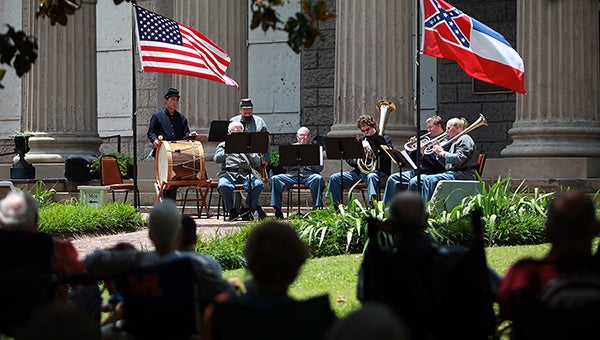VNMP closes sesquicentennial events Monday
Published 11:09 am Tuesday, May 26, 2015

MEMORIAL DAY: Olde Towne Brass performs a concert of Civil War band music, played on actual period instruments Monday on the lawn of the Old Court House Museum. (Justin Sellers/The Vicksburg Post)
Civil War sesquicentennial events drew to a close Monday with two wreath-laying ceremonies to honor both Confederate and Union soldiers and a concert where the commemoration began — on the lawn of the Cold Court House Museum.
About 70 people attended each wreath-laying ceremony, and another 80 crowded onto the lawn of the museum where the Olde Towne Brass band performed Civil War era music on period instruments.
“We started our sesquicentennial commemoration here at the Old Court House, a building that saw it all. And with this concert by the Olde Towne Brass band, sesquicentennial events come to a close,” Vicksburg National Military Park ranger Tim Kavanaugh said.
The concert ended with a medley of “Dixie” and the “Bonnie Blue Flag” followed by an 1862 arrangement of “The Star Spangled Banner,” which was played when the American flag was re-raised over Fort Sumter following the war.
“These guys are really good,” said Bob Cunny, who came to watch a portion of the concert.
Earlier in the day, crowds gather at Soldiers’ Rest in Cedar Hill Cemetery where more than 5,000 Confederate soldiers are buried, and Vicksburg National Cemetery, where more than 17,000 U.S. veterans are laid to rest.
“I cannot imagine a more fitting and proper way to observe this holiday, and that is paying homage to those men who wore both blue and gray and fell in service to their county,” Kavanaugh said.
Lamar McMilin said he was pleased to see large crowds at both wreath-layings organized by the park. Rarely does VNMP officials hold events in Soldiers’ Rest, if ever before, he said.
“It’s that town and gown mentality, with the park being the gown. When they do events like this, both sides benefit,” McMillian said.
Kavanaugh said the park service honors the sacrifices of Confederates, even if they aren’t buried in the national cemetery. Coincidently, two Confederate soldiers were mistakenly buried in the cemetery, and First National Confederate flags were placed on their graves for the weekend.
“Although this is not part of the park, those who are buried here are very much in our hearts,” Kavanaugh said at Soldiers’ Rest.
Modern estimates put the cost of life of the Civil War at more than 800,000, about 5 percent of the U.S. population at the time, Vicksburg National military Park interim superintendent Bill Justice said.
“There was not a person in the country who did not have a friend or family member affected by the war,” he said.
More than 13,000 of the Union troops killed in Vicksburg or the surrounding area are buried in graves marked only with numbers in the national cemetery. The soldiers were not unknown at the times of their deaths, Kavanaugh said. Often a soldier’s body would be buried by his friends, relatives or neighbors who were also in his regiment. But during the war, makeshift tombstones were made out of cracker box boards.
“In Mississippi, and in the deep, humid South, that wood doesn’t last long,” he said.
Somewhere deep in a government archive could be paperwork that could help identify thousands of soldiers buried in Vicksburg.





